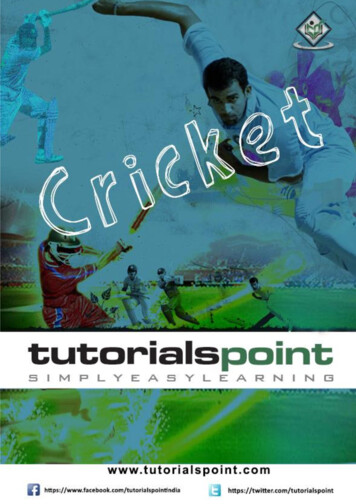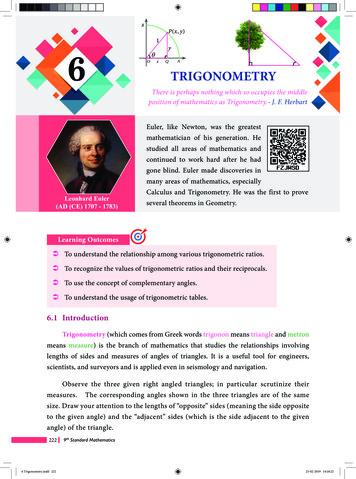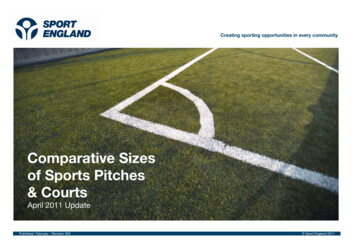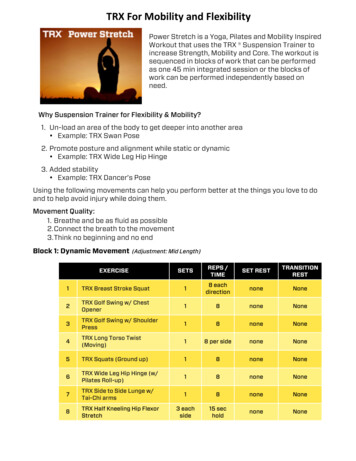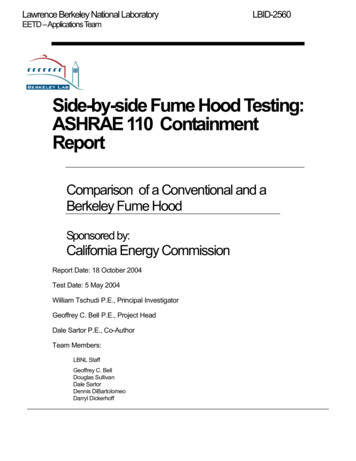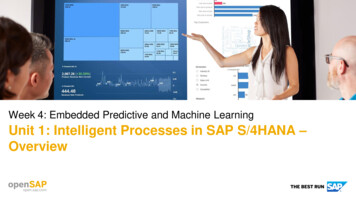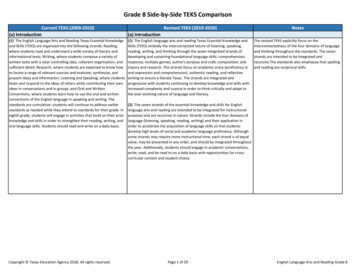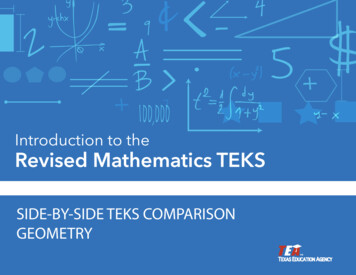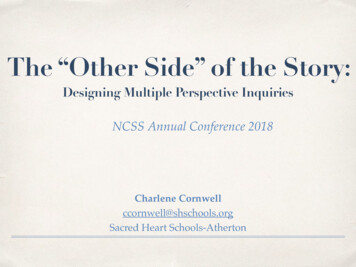
Transcription
The “Other Side” of the Story:Designing Multiple Perspective InquiriesNCSS Annual Conference 2018Charlene Cornwellccornwell@shschools.orgSacred Heart Schools-Atherton
Our Inquiry:Why are multiple perspectives important in oursocial studies instruction?How do we integrate diverse voices into ourcurriculum?
Workshop Agenda Role Play Research and Rationale Case Study of Multiple Perspectives Unit in a 5thGrade Classroom Ways to Use Multiple Perspectives in Your ElementaryClassroom
Playground ScenarioYou’re on recess duty and a verbal altercation breaks out between twostudents playing soccer. The students are yelling insults and you arrive onjust as the students are starting to push each other. You quickly defuse thesituation. Now, you need to figure out what happened, but the studentshave conflicting stories.How do you figure out the situation?Adapted from “Lunchroom Fight" by Stanford History Education Group
Think About Whois involved in the situation? Who do you talk to about the fight? What do you know about the participants/witnesses? What may affect a source’s credibility? How to you ensure a source’s credibility?
What factors can affectyour decision? If the stories make senseThe reputation of the studentsWhere you and the witnesses were during the fightThe relationship the kids in the fight have with each otherThe relationship they have with the witnessesDo you empathize with one of the participants? Or one of thewitnesses?The stake that someone has in the conflictHow emotional or hurt are the participants
To fully understand a situation, youneed to:Listen to multiple perspectivesEvaluate sources of information
“The primary purpose of socialstudies is to help young people makeinformed and reasoned decisions forthe public good as citizens of aculturally diverse, democratic societyin interdependent world.”–NCSS, 1994
Equitable Democracy is the Goal. Anti-biased and participatory democratic approach:See ourselves as part of a greater wholeListen to and learn from people who are different fromourselvesDevelop critical thinking skillsDeliberate to find peaceful solutions to problemsPromote the freedom, rights, and well-being of all people(Parker & Beck, 2017; Epstein, 2009; Banks, 2016; Wade, 2007)
Building Empathy in Social Studies Empathy is the ability to understand someone else’sthoughts, feelings, or experiences from their perspective. Requires students to:Understand the contexts that create different points ofviewCare about people and the injustices they experienceCare about improving society for the benefit of everyone(Barton & Levstik, 2009)
One-Sided Stories Elementary social studies curriculum relies heavily on one sourcethe textbook.Chooses what and whose knowledge is most importantNeglects certain voices, simplifies the complexity of situations, andomits how people influence society Dire consequences:Students do not have models for working together to solve issuesplaguing our society.Students of marginalized groups don’t see themselves in US history.(Loewen, 2018; Epstein, 2009; Agarwal-Rangnath, 2013; Wade, 2007)
“The stories that history textbooks tell arepredictable; every problem has alreadybeen solved or is about to be solved.Textbooks exclude conflict or realsuspense They portray the past as asimple morality play.”–James Loewen, 2007
Preparing to Teach with MultiplePerspectivesLearning StandardConnection to the PresentWho was involved?Group AContextBeliefsActionsDissensionGroup BContextBeliefsActionsDissensionTaking Action
Learn the History of the “Other Side”
Case Study:Taíno People and the ColumbusGoals:1. To include neglected perspectives2. To teach students that historical events havemultiple perspectives3. To teach students to critically evaluate sources
Learning Standard: “Students trace the routes of early explorers anddescribe the early explorations of the Americas”.Connection to the PresentWho was involved?Group AContextBeliefsActionsDissensionGroup BContextBeliefsActionsDissensionTaking Action
Inquiry Design Model Compelling question Scaffolded tasks Sources Construction of an evidence-based argument Take action
Framing the InquiryWhat is the connection between the standardand our current events?ABC7 News, 2018
What QuestionsDo You Have? Evaluative compellingquestions If appropriate, invite thestudents to craft compellingquestions. Used Visible Thinking Strategy,“Think, Puzzle, Explore”(Making Thinking Visible by Ron Ritchhart, et al.)
Should Columbus beHonored as a Hero?1. How does our identity shape our perspectives ofevents?2. How can a source affected by the author’s identity?3. What was the perspective of the Native Americans?4. What was the perspective of the Europeans?
Gathering Sources Several sources from multiple perspectives Primary and secondary sources
Supporting Question #1:How Does Our Identity Shape Our Perspective of Events? Define “Identity” Create Identity Webs Lunchroom Food Fight Scenario
Defining IdentityStudent NameStudentName
Lunch Food Fight Scenario“Your identity can make you biassomeone. If there is somebody whobullies you, you could exaggeratejust to get even with them. Or itcould be the other way around andyou could protect somebody youare friends with and you don’twant him to get in trouble. Thismight make your story different.”– Jamal, 5th graderAdapted from “Lunchroom Fight" by Stanford History Education Group
Supporting Question #2:How is a Source Affected by the Author’s Identity?Teach Students to Evaluate Sources! Read Encounter by Jane Yolen, Follow the Dream: The Story of ChristopherColumbus by Peter Sis, and History Alive! textbook Reflection:1. What kind of source is this book?2. Who is this story about?3. Whose point of view is represented? What is your evidence?4. Whose point of view is not included? What is your evidence?5. How does the author feel about Columbus? Native Americans? What isyour evidence?6. Who is the author? What do we know about him/her?(VanSledright, 2015; Loewen, 2018; Sleeter, 2017)
“The textbook only has 6 sentences out of 58 that evenmention the Native Americans. It does have onesentence about how Columbus enslaved them and howmany died. But most of it tells how Columbus wanted togo explore and finally got a king and queen to help himand he succeeded. The authors want us to focus on thatinstead of all the bad things. It’s biased.”–Brittney, 5th grader
Supporting Question #3:What is the Perspective of the Native Americans? Understand the historical context of Taíno people Use secondary sources to understand the impact of the encounter:Taíno MuseumEncounter by Jane Yolen“Columbus and the Indians” from A Young People’s History of the UnitedStates by Howard Zinn“Taíno Resistance: Enrique’s Uprising” in Rethinking Columbus Reflection: Connect the impacts on the Taíno people with your learning abouttheir values, beliefs, and experiences.
Making Thinking Visibleby Ron Ritchhart, et al.
“What? I knew they [Native Americans] died but I hadno idea it was this bad! They almost all died! They madethem slaves to find gold but it was an impossible task.Then they [Europeans] chopped off their hands if theycouldn’t. This is horrible.”–Sacha, 5th grader
Supporting Question #4:What is the Perspective of the Europeans? Understand the historical context of Columbus Use primary sources to understand motivations for explorationExcerpt from Pope Alexander VI’s Doctrine of Discovery, 1493Excerpt from Columbus’ journalAdapted excerpt from Bartolomé de Las Casas’s “Hispaniola” Compare to secondary sources’ coverage of the motivations Reflection: Connect the motivations to your learning of the generalbeliefs, values, and experiences of Western Europeans
Circle of ViewpointsMaking Thinking Visible by Ron Ritchhart, et al.
Concluding Supporting Question #2:How Can a Source be Affected by the Author’s Identity? Reflect on the sourcing task What conclusions can you draw about the connectionbetween the author’s identity and their perspective onthe text? Are all sources biased? What can we do to ensure credibility of a source?
“Your identity might make you have a bias when you talk about anevent. Peter [Sis] was an immigrant and was inspired byColumbus so his story is about Columbus being a hero. Jane Yolenis a woman and she maybe can connect to the Native Americansbecause women were hurt in history too. So in her story, she wantsto tell the Native American side of the story since it’s missing. Shealso didn’t think Columbus was a hero and made him like evilserpent in the story.”–Chloe, 5th grader“People have identities. Their identities make them take a side. Youhave to read lots of different stories from Native Americans andEuropeans to make sure you see both sides. You have to readprimary sources too. That way you can see exactly what theythink.”–Nicolas, 5th grader
Summative Argument Task:Should Columbus Be Honored as a Hero? Take a position and support withevidence 5 paragraph essay using Document-BasedQuestion structure Debate/Socratic Seminar
Taking Action:Should Columbus BeHonored as a Hero? Workwith a partner to plan andimplement an action project thatsupports your position. Projects:Slideshow presentations for3rd gradersLetter to principalLetter to the GovernorPresentation to the towncouncil
Additional Ways to Use MultiplePerspectives in Your Elementary Classroom Portable archives Book reviews Double-entry journals Timelines with multipleperspectivesLiterature circles withbooks from variousperspectives Role-play/simulations Readers Theater Diary entries Dialogue poems Guest speakersField tripsRound-tablenegotiations
“Of course, we have to learn both sides ofthe story. A teacher has to hear both sidesduring a fight on the playground Thenwe have to learn about both sides ofstories in history too.”–Adnan, 5th grader
THANK YOUCharlene Cornwellccornwell@shschools.orgSacred Heart Schools-Atherton
ResourcesAgarwal-Rangnath, R. (2013). Social studies, literacy, and social justice in the common core classroom. New York, NY: Teachers College Press.Annenberg Foundation. (2017). The Renaissance: What inspired this age of balance and order. In The Annenberg Learner. Retrieved from dex.htmlAronson, M. and Glenn, J.W. (2007). The world made new: Why the age of exploration happened & how it changed the world. Washington, D.C.:National Geographic Society.Banks, J. A. (2016). Approaches to multicultural reform. In J.A. Banks and C.A. McGee Banks (Eds.), Multicultural education: Issues andperspectives. Hoboken, NJ: John Wiley and Sons, Inc.Barton, K.C. and Levstik, L.S. (2009). Teaching history for the common good. New York, NY: Routledge. (Original work published in 2004.)Barton, K.C. and Levstik, L.S. (2015). Why don’t more history teachers engage students in interpretation? In W. Parker (Ed.), Social studies today:Research and practice (2nd ed., pp. 35-42). New York, NY: Routledge.California Department of Education. (2000). History-social science content standards for California public schools: Kindergarten through grade 12.Sacramento, CA: Department of Education. Retrieved from cistnd.pdf.[CBS New York]. (2017, October 9). Columbus controversy. [Video File.] Retrieved from https://www.youtube.com/watch?v zaFWUDJuC4I&t 1sColumbus, Christopher. (2005). Journal of the first voyage of Columbus. In C. R. Markham (Ed. & Trans.), The Journal of Christopher Columbus anddocuments relating to the voyages of John Cabot and Gaspar Corte Real (pp. 35-40). London, UK: Adamant Media Corporation.de Las Casas, B. (2004). Hispaniola. In N. Griffin (Ed.& Trans.), Bartolome de Las Casas: A short account of the destruction of the Indies (pp. 14-17).London, UK: Penguin Books. (Original work published in 1992.)Discovery Education (Producer). (2006). Culture and math: The Renaissance. [Video File]. Retrieved from 4dfc00-c48f-4239-a9d9-92d07c306ac6Epstein, T. (2009). Interpreting national history: Race, identity, and pedagogy in classrooms and communities. New York: Routledge, Taylor &Francis.
Josephy, Jr., A. (1998). Taino resistance: Enrique’s uprising. In B. Bigelow & B. Peterson (Eds.), Rethinking Columbus. Milwaukee, WI:Rethinking Schools.Lee, E. (2007). Taking multicultural, anti-racist education seriously: An interview with Enid Lee. In Au, W., Bigelow, B. and Karp, S. (Eds.),Rethinking our classrooms: Teaching for equity and justice, Volume 1. Milwaukee, WI: Rethinking Schools.Loewen, J. W. (2018). Teaching what really happened: How to avoid the tyranny of textbooks and get students excited about doing history (2 ed.). NewYork, NY: Teachers College Press.ndNational Council for the Social Studies (NCSS). (1994). Expectations of excellence: Curriculum standards for social studies. Washington, D.C.: NCSS.National Council for the Social Studies (NCSS). (2013). The College, Career, and Civic Life (C3) Framework for social studies state standards:Guidance for enhancing the rigor of K-12 civics, economics, geography, and history. Silver Spring, MD: NCSS. Retrieved from c3/C3-Framework-for-Social-Studies.pdfParker W. and Beck, T. A. (2017). Social Studies in Elementary Education. (15 ed.) Boston, MA: Pearson.Pope Alexander VI. (1493). Demarcation bull granting Spain possession of lands discovered by Columbus. In Gilder Lehrman Collection. Retrievedfrom inline-pdfs/T-04093.pdfth(2018). The Renaissance: How did it begin? In Ducksters Education Site. Retrieved from https://www.ducksters.com/history/how did the renaissance start.phpRitchardt, R., Church, M., and Morrison, K. (2011). Making thinking visible: How to promote engagement, understanding, and independence for alllearners. San Francisco, CA: Jossey-Bass.Sis, Peter. (1991). Follow the dream: The story of Christopher Columbus. New York, NY: Alfred A. Knopf.Sleeter, C. E. and Flores Camona, J. (2017). Un-standardizing curriculum: multicultural teaching in the standards-based classroom (2nd edition). NewYork, NY: Teachers College Press.Stanford History Education Group. (2009). Lunchroom fight. Retrieved from no Museum. (2018). Genocide. Retrieved from https://tainomuseum.org/taino/genocide/
Tyler, C. (2018, January 22). Should San Francisco rename Columbus Day Indigenous People’s Day? ABC7 News. Retrieved from umbus-day/2978268/VanSledright, B. (2015). What does it mean to think historically and how do you teach it? In W. Parker (Ed.), Social studies today: Research andpractice (2nd ed., pp. 144-150). New York, NY: Routledge.Wade, R. C. (2007). Social studies for social justice: Teaching strategies for the elementary classroom. New York, NY: Teachers College Press.Yolen, Jane. (1996). Encounter. Boston, MA: HMH Books for Young Readers.Zinn, H. (2009). The young people’s history of the United States. New York, NY: Seven Stories Press.
to tell the Native American side of the story since it’s missing. She also didn’t think Columbus was a hero and made him like evil serpent in the story.” –Chloe, 5th grader “People have identities. Their identities make them

